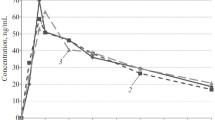Summary
The influence of single doses of quinidine sulphate (Q) 0.5 g, sparteine sulphate (SP) 0.2 g, and placebo (PL) on heart rate-corrected systolic time intervals (STI) (QS2c, PEPc, LVETc) and on QTc duration was studied 2 and 4 h after treatment of six healthy volunteers. All measurements were done twice in a double blind fashion, once under digoxin (D) steady state (β-methyl digoxin 0.3 mg daily) and once after an equally prolonged basic treatment period with PL. All basic treatment periods and single dose periods were randomized. Drug effects were estimated by comparison with the results obtained after administration of the corresponding placebo. The data were analyzed by two-factorial multivariate analysis of variance. Steady state digoxin serum concentrations averaged 1.3 µg/l and there was no significant change following antiarrhythmic drugs compared to PL. Single oral doses of Q and SP resulted in mean serum concentrations of about 1.8 mg/l and 0.25 mg/l, respectively. In non-digitalized subjects Q 0.5 g resulted in a lengthening of QS2c (+15 ms), LVETc (+13 ms) and QTc (+65 ms). With SP 0.2 g similar but smaller effects were seen. D alone resulted in shortening of QS2c (−21 ms), LVETc (−14 ms), and QTc (−32 ms). Pretreatment with D did not influence the effects of Q on the various parameters. However, corresponding to the D-induced changes in STI, a parallel shift of the curve was observed. The effects of sparteine were somewhat reduced by D. Most of the effects of Q compared to PL and SP were statistically significant (p<0.05) during both basic treatments, and the D basic treatment had a statistically significant effect for all treatment regimens, but there was no significant interaction between them. In contrast to others, the present results indicate that the positive inotropic effect of D persists in the presence of Q and SP, and that the antiarrhythmic drugs induce negative inotropic effects independent of basic treatment with D. Under the conditions of this experiment, each drug maintains its negative or positive effect on inotropy, thus resulting in an almost arithmetical superposition of the separate drug effects.
Similar content being viewed by others
References
Bazett HC (1920) An analysis of the time relations of the electrocardiogram. Heart 7:353–370
Belz GG, Erbel R, Schumann K, Gilfrich HJ (1978) Dose response relationships and plasma concentrations of digitalis glycosides in man. Eur J Clin Pharmacol 13:103–111
Belz GG, Czermak E, Belz G (1979) Die zeitliche Kinetik der Wirkung von Digitoxin und β-Acetyldigoxin nach oraler Applikation beim Menschen. Z Kardiol 68:77–81
Belz GG, Riedlinger G (1980) Nichtinvasive Untersuchungen zur kardialen Wirkung niedriger Digitoxin-Erhaltungsdosen. Z Kardiol 69:296–306
Borner K, Rietbrock N (1978) Bestimmung von Digoxin im Serum. Vergleich von Radioimmunoassay und heterogenem Enzymimmunoassay. J Clin Chem Clin Biochem 16:335–342
Cramér G, Isaksson B (1963) Quantitative determination of quinidine in plasma. Scand J Clin Lab Invest 15:553–556
Dengler HJ, Eichelbaum M, Hengstmann J, Wieber J (1970) Pharmacokinetic studies in man with sparteine. Pharmacol Clin 2:189–195
Doering W, König E (1978) Anstieg der Digoxinkonzentration im Serum unter Chinidinmedikation. Med Klin 73:1085–1088
Doering W (1979) Quinidine-digoxin interaction. Pharmacokinetics, underlying mechanism and clinical implications. N Engl J Med 301:400–404
Doering W, Höhe M, König E (1980) Digoxin-Chinidin-Interaktion. Neue klinisch-pharmakologische Aspekte. Z Kardiol 69:186
Doering W, Belz GG (1981) Quinidine-digoxin interaction: Effect of quinidine on 86 Rb-uptake of human erythrocytes. Klin Wochenschr 59:95–96
Ejvinsson G (1978) Effect of quinidine on plasma concentrations of digoxin. Br Med J 1:279–280
Erbel R, Belz GG (1977) Untersuchungen zur Meßmethode der systolischen Zeitintervalle. Z Kardiol 66:433–435
Fieldman A, Beebe RD, Chow MSS (1977) The effect of quinidine sulfate on QRS duration and QT and systolic time intervals in man. J Clin Pharmacol 17:134–139
Forester W, Lewis RP, Weissler AM, Wilke TA (1974) The onset and magnitude of the contractile response to commonly used digitalis glycosides in normal subjects. Circulation 49:517–521
Gold M, Modell W, Price L (1932) Combined actions of quinidine and digitalis on the heart. An experimental study. Arch Int Med 50:766–796
Hager WD, Fenster P, Mayerson M, Perrier D, Graves P, Marcus FJ, Golman S (1979) Digoxin-quinidine interaction. Pharmacokinetic evaluation. N Engl J Med 300:1238–1241
Hirsh PD, Weiner HJ, North RL (1980) Further insights into digoxin-quinidine interaction: Lack of correlation between serum digoxin concentration and inotropic state of the heart. Am J Cardiol 46:863–868
Leahey EB, Reiffel JA, Heissenbuttel RH, Drusin RE, Lovejoy WP, Bigger JT (1979) Enhanced cardiac effect of digoxin during quinidine treatment. Arch Intern Med 139:519–521
Lewis RP, Rittgers SE, Forester WF, Boudoulas H (1977) A critical review of the systolic time intervals. Circulation 56:146–158
Moe GK, Abildskow JA (1975) Antiarrhythmic drugs. In: LS Goodman and A Gilman (eds) The Pharmacological Basis of Therapeutics, 5th edit. MacMillan, New York, pp 691–692
Rosenkranz KA (1968) Medikamentöse Vor- und Nachbehandlung bei der Elektrotherapie von Herzrhythmusstörungen. Med Welt 19:2830–2833
Steiness E, Waldorff S, Hansen PB, Kjaergard H, Buch J, Egeblad H (1980) Reduction of digoxin-induced inotropism during quinidine administration. Clin Pharmacol Ther 27:791–795
Weissler AM, Snyder JR, Schoenfeld CD, Cohen S (1966) Assay of digitalis glycosides in man. Am J Cardiol 17:768–780
Weissler AM, Harris WS, Schoenfeld CD (1968) Systolic time intervals in heart failure in man. Circulation 37:149–159
Weissler AM, Schoenfeld CD (1970) Effect of digitalis on systolic time intervals in heart failure. Am J Med Sci 259:4–20
Wezler K, Böger A (1938) Die Dynamik des arteriellen Systems. Ergebn Physiol 41:292–606
Wick E, Bell U, Dengler HJ (1971) Die Wirkung von Sparteinsulfat auf mechanisch ausgelöste Extrasystolen beim Menschen. Med Welt 22:303–306
Author information
Authors and Affiliations
Additional information
These results form part of a thesis of M. Heinz
Rights and permissions
About this article
Cite this article
Belz, G.G., Aust, P.E., Doering, W. et al. Pharmacodynamics of a single dose of quinidine during chronic digoxin treatment. Eur J Clin Pharmacol 22, 117–122 (1982). https://doi.org/10.1007/BF00542455
Received:
Revised:
Accepted:
Issue Date:
DOI: https://doi.org/10.1007/BF00542455




